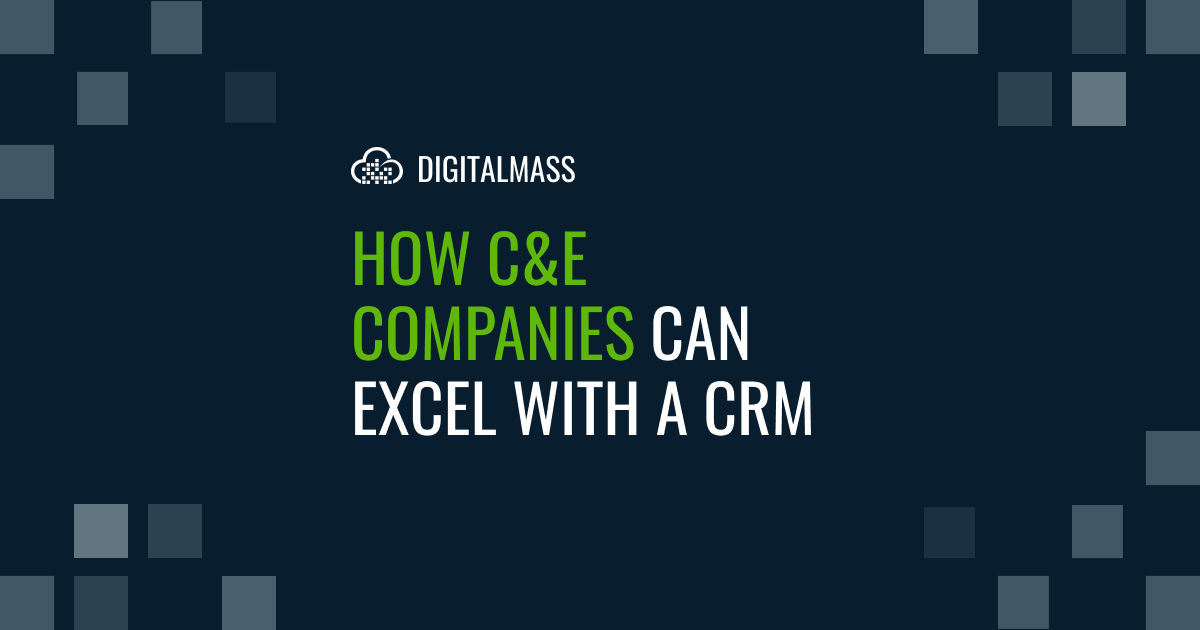How C&E Companies can Excel with a CRM
Alex Colburn – May 18, 2021

How Construction and Engineering Companies can Excel with a CRM
There’s nothing easy about pursuing work within an industry like construction and engineering. It’s an industry that is floor-to-ceiling (pun fully intended) chock-full of details that, if left unnoticed, could spell certain doom for an Opportunity from the moment you get an RFQ or RFP to the interview, and beyond selection, as pre-con work kicks off.
But there are a few ways that a construction and engineering company can take advantage of the capabilities that Salesforce provides to centralize information and win more work. In this article, we’ll touch on relationship management, Salesforce CPQ, and reporting on analytics. If you’d rather skip the reading portion and talk to an expert on our team, you can do that here.
Elevate your Relationship Management
When people hear “Salesforce'' they automatically think “CRM”. Customer Relationship Management refers to a centralized, single source-of-truth representation of the relationship between a business and its customers. Although Salesforce has capabilities that go far beyond being just a CRM, they do customer relationship management incredibly well.
For the construction and engineering industry this kind of software is a no-brainer because if there’s one cornerstone of the construction industry, it’s the relationships.
Within construction and engineering companies, the most up-to-date and realistic representation of clients, partners, and competitors is usually stored in an Outlook list, an Excel file, or within a business development rep. While that system might work for a while, it’s certainly not sustainable. With no central source of truth, there’s no strategy behind relationship management. This is problematic for many reasons, but frankly, it’s an outdated way of trying to manage the work pipeline.
With a CRM like Salesforce, gone are the days of isolated Outlook contact lists, desktop-stored excel workbooks filled with activity history and clear-as-mud communication between team members.
Let Salesforce help elevate and automate your relationship management.
Configure Salesforce CPQ to Empower Quotes and Estimates
There’s nothing easy about pursuing work in the construction and engineering industry. And while no one part of the pursuit is necessarily “easier” than the other, a critical piece of the puzzle is any estimating or quoting work you’ll be doing along the way.
It’s becoming more common for prospective clients to ask for preliminary estimates before getting in a room with you as part of a shortlisting process. This is where the Salesforce CPQ (Configure, Price, Quote) utility comes in handy.
Using much of the same information you would have already entered into Salesforce for an Opportunity, you can generate a consistent scope estimating process using the pricing logic that you and your team have defined and manage. Because Salesforce CPQ supports pricing logic as simple or as complex as your business needs, you can rest easy knowing that it will support a cost consideration for union jobs and manage the unique state and local requirements that will influence your bid.
Implementing a pricing tool like Salesforce CPQ adds transparency to your pricing process both internally for business development reps and externally for customers who want to know more about how you got to the number in front of them. Beyond serving as a comprehensive utility for pricing your services, Salesforce CPQ builds trust, and in this industry, more than most - trust is as good as gold.
Be Confident in What you’re Reporting On
Construction and engineering opportunities come in a variety of flavors. Some days, a client that you have a master maintenance agreement with will request you be at their headquarters tomorrow to fix broken light fixtures. In other cases, you respond to an RFP with a few weeks of lead time and scramble to pull together the necessary data and people in advance. And in increasing frequency - larger commercial contractors are positioning work for months or even years before finally sitting face-to-face with an owner or their rep.
Pursuits are varied, complex, and only surpassed in complexity by the projects they hopefully materialize into. So, why not make sure that all of that hard work, both before and after shovels hit the dirt, is paid for in derived quality reporting and analytics?
Luckily, Salesforce comes equipped with robust out-of-the-box reporting functionality that is both configurable and accessible by your everyday users. By taking advantage of Salesforce CRM, construction pipelines, and pursuit history is stored in one place, and you’ll no longer be left to wonder about the quality of your RFQ or RFP responses due to data being sourced from all over the place.
Be confident in your data by implementing a CRM that business users can be owners and stewards of. It’s an added bonus that the affected parties aren’t just your business development and marketing teams, but team members at every level. You won’t have to keep struggling with pipeline reporting or keep a Sales/selection process alive in Excel. Senior leaders will appreciate the expediency and transparency that centralized pursuit data and reporting creates. So, spend less time collecting and cleaning data, and more time helping your Sales teams win more work.
At the end of the day…
There are so many details that could derail a project from getting started. Instead of leaving room for error, take advantage of the capabilities that Salesforce offers to help manage your relationships, easily report on data, and provide transparency into the estimating and quoting process - all in one place.
See what a Digital Mass developer has to say about relationship management and Salesforce CPQ in Episode 0.6 of The Developers Speak.
If you’re interested in exploring different ways that a CRM can help the company you’re working at excel, let’s find time to talk about it.